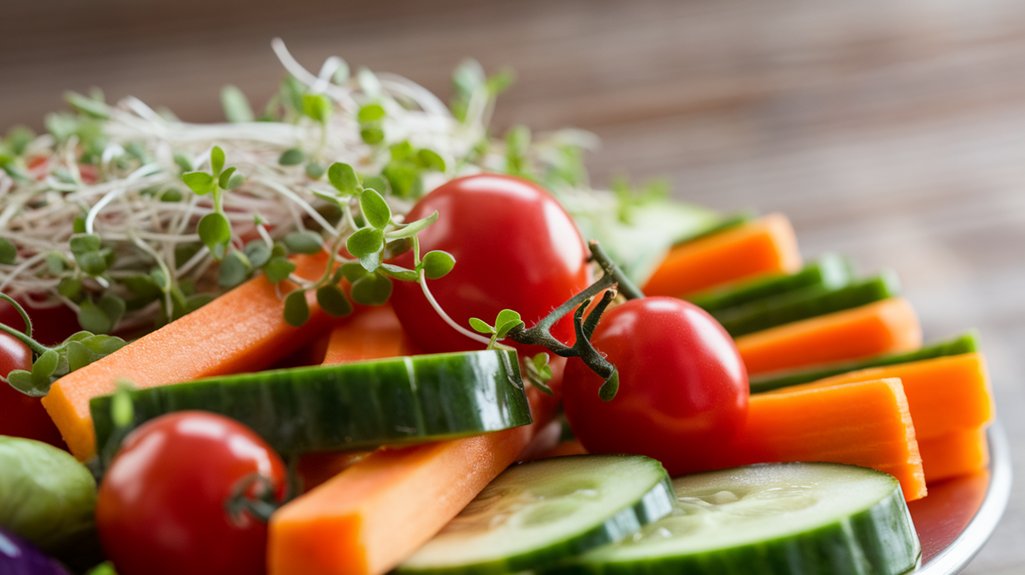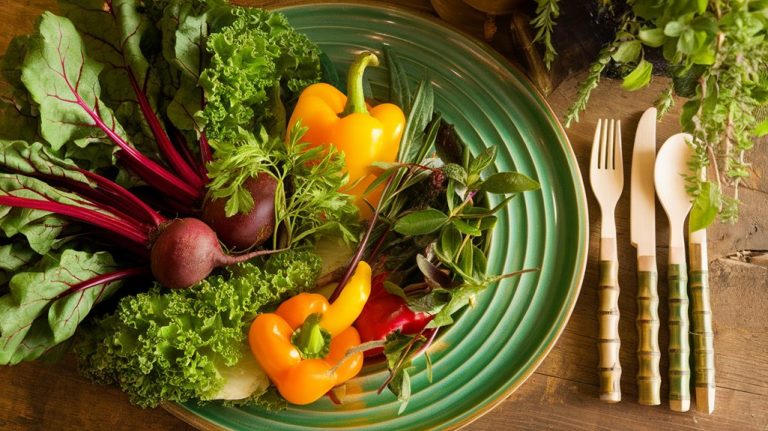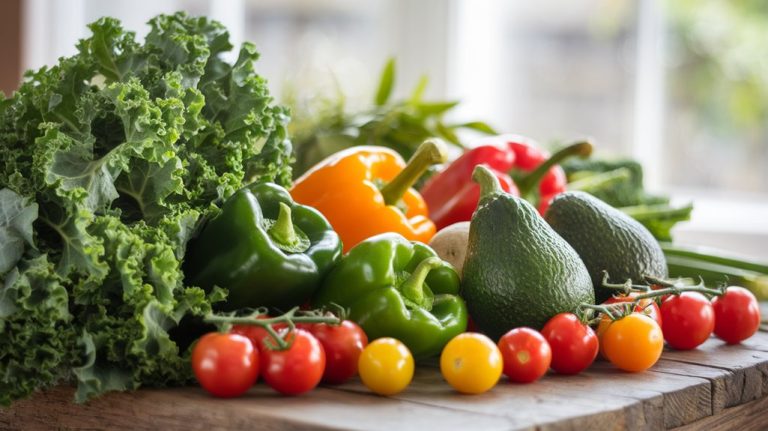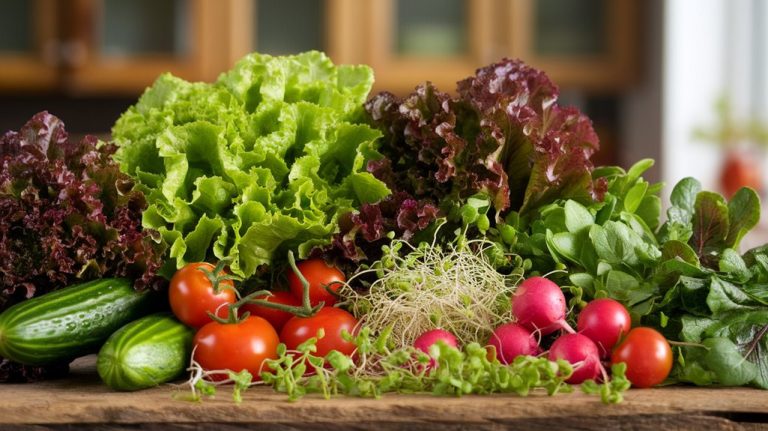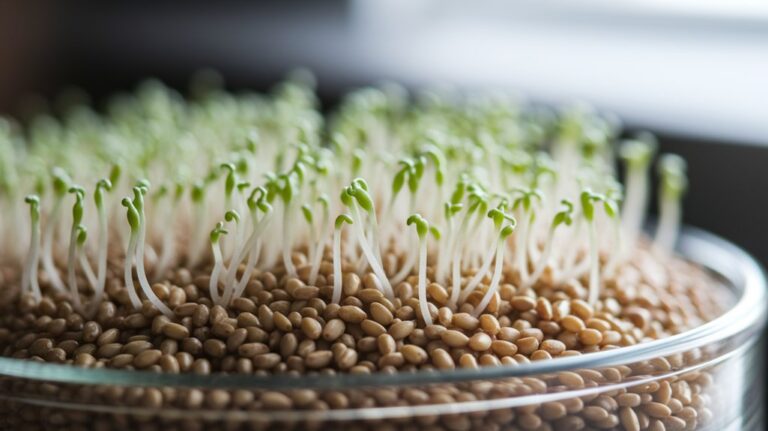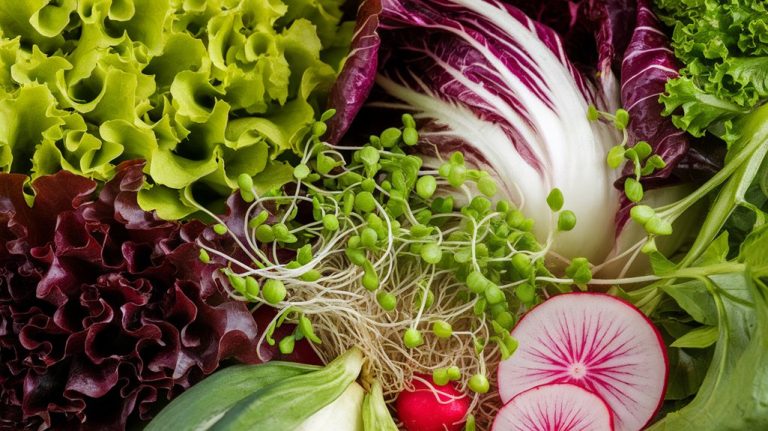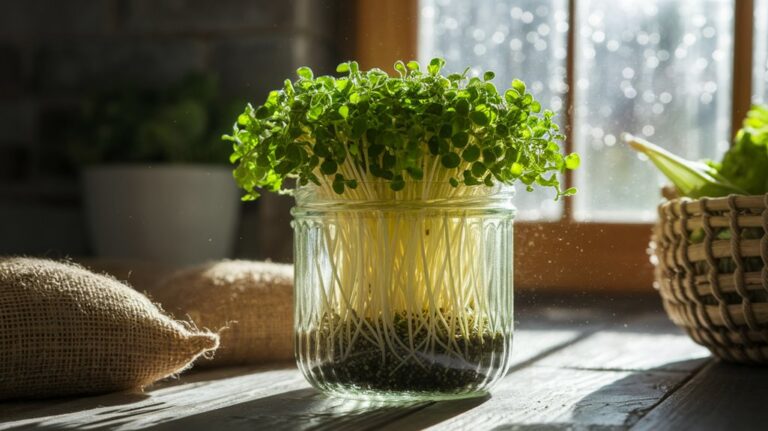Crisp, Colorful, and Clean Eats With Vegetables and Sprouts
I love incorporating vibrant vegetables and nutrient-rich sprouts into my meals for a burst of flavor and nutrition. Leafy greens, colorful bell peppers, and sprouts like alfalfa and broccoli not only add crunch but also boost my immune system. I often toss them into salads, smoothies, or stir-fries for quick, wholesome dishes. Plus, with unique dips and spreads, I can elevate my veggie platters. If you’re curious, there’s so much more to explore about these clean eats!
Key Takeaways
- Incorporate a variety of colorful vegetables, like bell peppers and leafy greens, to boost visual appeal and nutritional value in meals.
- Add nutrient-dense sprouts, such as alfalfa and broccoli, to salads and dishes for added crunch and health benefits.
- Create vibrant salads, like Rainbow Quinoa Salad or Tropical Spinach Salad, to showcase colorful ingredients and enhance presentation.
- Prepare quick stir-fry dishes with fresh vegetables and protein, retaining nutrients while delivering crisp textures and flavors.
- Experiment with unique dips, such as roasted red pepper hummus or fresh herb spreads, to elevate the enjoyment of raw vegetables.
The Nutritional Power of Vegetables and Sprouts
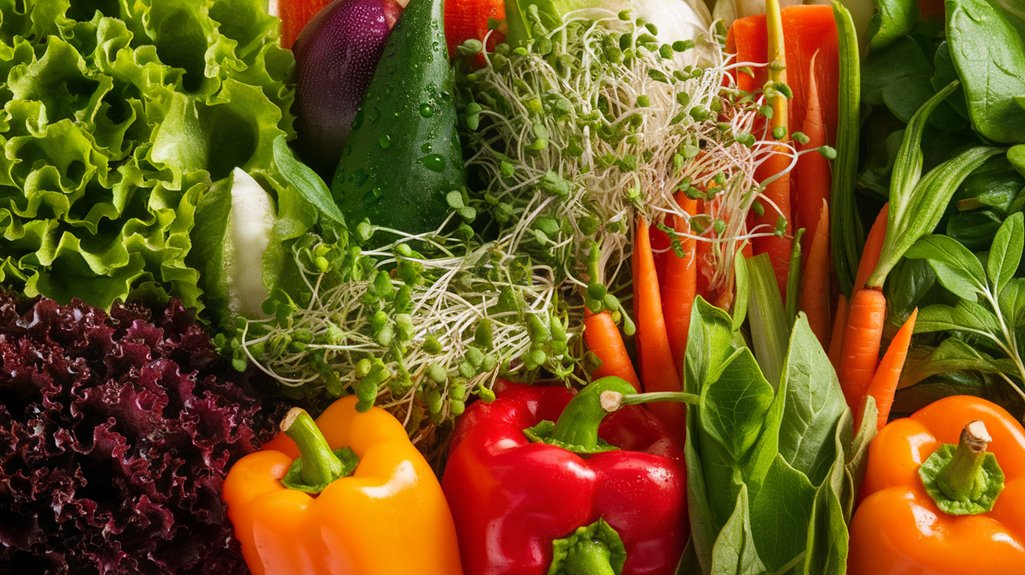
When I think about the incredible benefits of vegetables and sprouts, I can’t help but be amazed at their nutritional power.
These vibrant foods are packed with vitamins, minerals, and antioxidants that support our overall health. For instance, leafy greens like spinach and kale are rich in iron and calcium, while colorful bell peppers provide a hefty dose of vitamin C.
Sprouts, like alfalfa and broccoli, are nutrient-dense and contain compounds that may boost our immune system. They’re low in calories yet high in fiber, making them perfect for digestion.
Incorporating a variety of these foods into my diet not only enhances my meals but also fuels my body with essential nutrients. It’s a delicious way to promote wellness!
Creative Ways to Incorporate Sprouts Into Your Meals
With all the nutritional benefits sprouts offer, it’s exciting to find creative ways to add them to my meals.
I love tossing a handful of alfalfa sprouts onto my sandwiches for a crunchy texture. They also make a fantastic topping for tacos, giving them a fresh twist.
When I’m in the mood for something warm, I stir-fry bean sprouts with colorful veggies and a splash of soy sauce, making a quick and delicious side.
You can even blend sprouts into smoothies for an extra nutrient boost—just a small handful goes a long way!
Lastly, I often sprinkle radish sprouts over my omelets, turning a simple dish into a gourmet experience.
Sprouts truly elevate any meal!
Colorful Salad Ideas That Wow
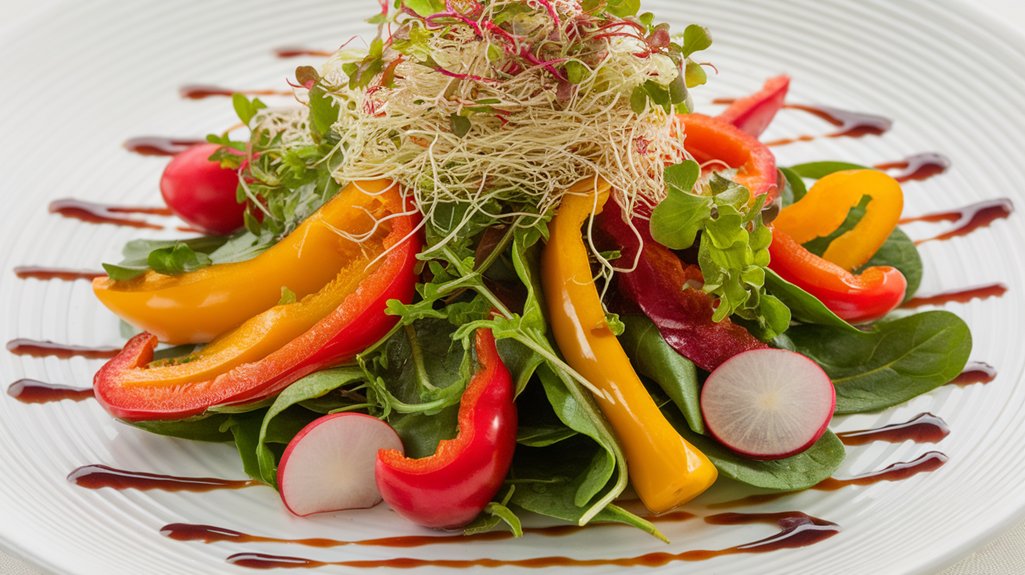
Salads can be a vibrant and exciting part of any meal, especially when you know how to mix and match colorful ingredients.
I love creating salads that not only taste great but also look stunning. Here are three colorful salad ideas that wow:
- Rainbow Quinoa Salad: Toss cooked quinoa with diced bell peppers, cherry tomatoes, cucumbers, and a sprinkle of feta cheese. Drizzle with a lemon vinaigrette for a zesty finish.
- Tropical Spinach Salad: Combine fresh spinach, mango slices, avocado, and shredded carrots. Top it off with a honey-lime dressing for a sweet twist.
- Beet and Citrus Salad: Arrange roasted beets, orange segments, and arugula on a plate. Add walnuts and goat cheese for texture and flavor.
These salads are sure to impress!
Stir-Fry Delights: Quick and Healthy Options
Stir-frying is one of my favorite ways to whip up a quick and healthy meal, as it allows for endless combinations of fresh vegetables and proteins.
I love tossing in vibrant bell peppers, crunchy broccoli, and snap peas, all cooked to perfection in just a few minutes. The key is to have your ingredients prepped and ready to go; chop everything before you even turn on the heat.
For protein, I often use tofu or shrimp, which cook quickly and soak up flavors beautifully. A splash of soy sauce and a sprinkle of sesame seeds can elevate the dish tremendously.
Plus, stir-frying retains the nutrients in the veggies, making it a nutritious choice for any busy day. Give it a try!
Roasting Vegetables for Maximum Flavor
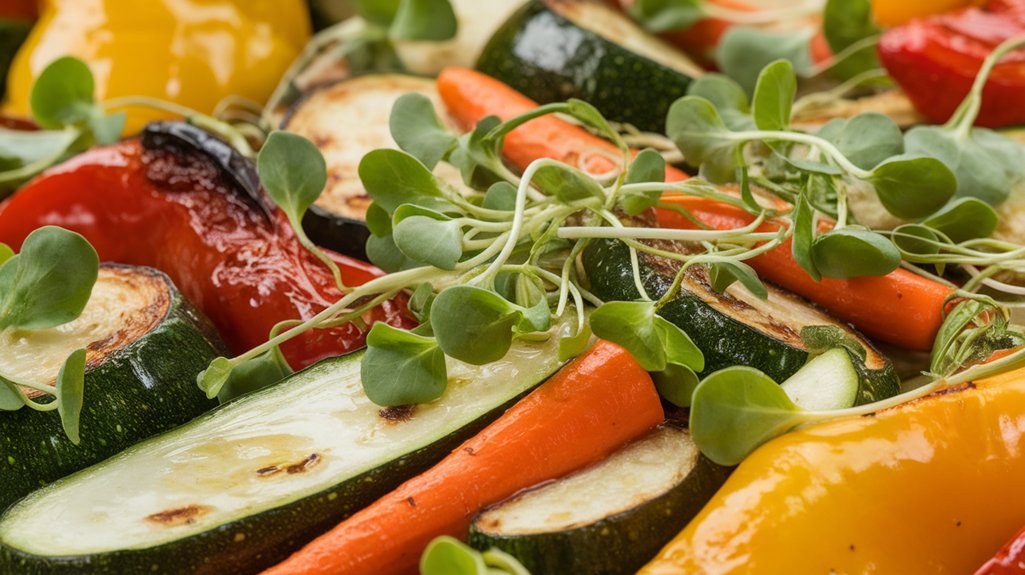
Roasting vegetables transforms their natural flavors and brings out a delicious sweetness that’s hard to resist.
I love how this simple cooking method enhances the taste of even the most humble veggies.
Here are three tips I swear by for perfect roasted vegetables:
- Choose the Right Veggies: Root vegetables like carrots, potatoes, and beets caramelize beautifully, while greens like Brussels sprouts add a delightful crunch.
- Season Generously: Olive oil, salt, pepper, and your favorite herbs elevate the flavors. Don’t be shy—seasoning is key!
- Mind the Temperature: Roasting at a high temperature, around 425°F, ensures they get that perfect golden-brown exterior while staying tender inside.
With these tips, you’ll enjoy vibrant and flavorful roasted vegetables every time!
Vibrant Smoothies Packed With Greens
While I often turn to roasted vegetables for a hearty side dish, vibrant smoothies packed with greens are my go-to for a quick, nutrient-dense meal. Blending leafy greens with fruits and other nutritious ingredients provides a delicious way to boost my daily vegetable intake. Here are some of my favorite smoothie combinations to inspire you:
| Green Base | Add-Ins |
|---|---|
| Spinach | Banana, Almond Milk |
| Kale | Pineapple, Coconut Water |
| Swiss Chard | Mango, Greek Yogurt |
| Collard Greens | Apple, Chia Seeds |
| Romaine Lettuce | Berries, Flaxseed |
Experimenting with different combinations lets me discover new flavors. So, grab your blender and start creating your own vibrant green smoothies!
Unique Vegetable Dips and Spreads
When it comes to unique vegetable dips and spreads, I’ve discovered some truly exciting options that can elevate any snack time.
From flavorful hummus variations to nutty dips that add a satisfying crunch, there’s something for everyone.
Plus, fresh herb spreads bring a burst of flavor that can transform your veggies into something special!
Flavorful Hummus Variations
There are countless ways to elevate your hummus game, and I’m excited to share my favorite flavorful variations that transform this classic dip into something extraordinary.
These unique twists not only enhance the taste but also add vibrant colors to your plate.
- Roasted Red Pepper Hummus: Blend roasted red peppers with your base for a smoky, sweet flavor that’s irresistible.
- Beet Hummus: Add cooked beets for a stunning magenta hue and an earthy sweetness that surprises every time.
- Spicy Harissa Hummus: Mix in a spoonful of harissa paste for a zesty kick that’ll awaken your taste buds.
Try these variations, and you’ll never look at hummus the same way again!
Nutty Dips for Crunch
Have you ever craved something crunchy to accompany your veggie platter? I’ve found that nutty dips are perfect for adding flavor and texture to my snacks.
One of my favorites is a creamy almond dip—just blend soaked almonds with garlic, lemon juice, and a touch of olive oil. It’s rich and satisfying!
Another winner is a cashew-based dip, where I mix soaked cashews with nutritional yeast, spices, and a splash of water for a delightful spread.
Sunflower seed dip is also a hit; it’s nut-free and pairs beautifully with crunchy carrots or celery.
These nutty dips not only enhance the crunch but also pack healthy fats and protein, making my veggie munching a more fulfilling experience!
Fresh Herb Spreads
Fresh herb spreads bring a burst of flavor to any vegetable platter, transforming ordinary dips into vibrant, aromatic experiences.
I love whipping up these spreads not just for their taste but also for their freshness. Here are three of my favorites:
- Basil Pesto: A classic blend of fresh basil, garlic, pine nuts, Parmesan, and olive oil. It’s perfect with carrots and bell peppers.
- Dijon Dill Spread: Combine Greek yogurt, fresh dill, lemon juice, and a hint of Dijon mustard. This creamy dip pairs wonderfully with crunchy cucumbers.
- Chimichurri: This zesty mixture of parsley, garlic, olive oil, vinegar, and spices adds a kick to any vegetable.
Try these spreads, and watch your veggie platters get devoured!
Plant-Based Bowls: A Canvas for Creativity
When I think about plant-based bowls, I see them as a perfect opportunity to mix flavorful ingredients and showcase vibrant sprouts.
Not only do these combinations elevate taste, but they also pack a nutritional punch that can energize your day.
Plus, with a little creativity in presentation, you can turn a simple meal into a stunning culinary masterpiece.
Flavorful Ingredient Combinations
While exploring the world of plant-based bowls, I find that the key to creating truly flavorful dishes lies in the art of combining vibrant ingredients.
Here are three ingredient combinations that never fail to impress:
- Roasted Sweet Potatoes & Black Beans: The sweetness of the potatoes balances perfectly with the earthiness of the beans, creating a hearty base.
- Quinoa & Fresh Herbs: Quinoa’s nutty flavor pairs beautifully with fresh herbs like cilantro or parsley, adding brightness and depth.
- Avocado & Citrus Dressing: Creamy avocado drizzled with a zesty citrus dressing elevates any bowl, bringing richness and tang together.
These combinations not only enhance taste but also make each bite a colorful and delightful experience.
Nutritional Boost From Sprouts
Incorporating sprouts into my plant-based bowls takes flavor and nutrition to a whole new level. These tiny powerhouses are packed with vitamins, minerals, and enzymes that fuel my body. For example, I love adding alfalfa sprouts for their crunchy texture and rich vitamin K content. Broccoli sprouts are another favorite, boasting impressive levels of sulforaphane, a compound known for its health benefits.
Here’s a quick look at some popular sprouts and their nutritional highlights:
| Sprout Type | Key Nutrients |
|---|---|
| Alfalfa Sprouts | Vitamin K, C, and fiber |
| Broccoli Sprouts | Sulforaphane, vitamins A and C |
| Mung Bean Sprouts | Protein, fiber, and antioxidants |
Adding these vibrant sprouts not only enhances taste but also offers a significant nutritional boost to my meals.
Creative Presentation Ideas
Plant-based bowls are a vibrant canvas where creativity thrives, and I love experimenting with different presentation ideas to make my meals visually appealing.
Here are three techniques I often use to elevate my dishes:
- Layering Colors: I arrange ingredients in distinct layers, showcasing the rainbow of vegetables. This not only looks stunning but also allows for a delightful mix of flavors with each bite.
- Edible Flowers: Adding edible flowers like nasturtiums or pansies gives my bowls a fresh, whimsical touch. They’re eye-catching and pack a nutritious punch!
- Artful Drizzles: A swirl of tahini or balsamic glaze can transform a simple bowl into an artistic masterpiece. It enhances both flavor and presentation, making every meal feel special.
Frequently Asked Questions
How Can I Store Fresh Vegetables and Sprouts for Longer Freshness?
When it comes to storing fresh vegetables and sprouts, I always make sure to keep them in the fridge.
I use breathable bags or containers to allow air circulation, preventing moisture buildup. For leafy greens, I wrap them in a damp paper towel before placing them in a bag.
Sprouts, on the other hand, stay fresher in a jar with a lid. This simple approach really helps me enjoy my produce longer!
Are There Any Specific Diets That Emphasize Vegetables and Sprouts?
Absolutely! I’ve found that several diets emphasize vegetables and sprouts.
For instance, the plant-based diet focuses heavily on whole, unprocessed foods, making veggies a star. The Mediterranean diet also encourages a variety of vegetables and sprouts, promoting health and flavor.
Even raw food diets often include lots of fresh sprouts for their nutrients. If you’re looking to boost your intake, these diets can be a great guide!
What Are the Best Ways to Wash and Prepare Sprouts Safely?
When it comes to washing and preparing sprouts safely, I always start by rinsing them under cold water in a fine mesh strainer.
I gently agitate them to remove any dirt or debris.
Then, I soak them in a bowl of water with a splash of vinegar for about 10 minutes to kill bacteria.
After rinsing again, I pat them dry with a clean towel.
This method ensures my sprouts are fresh and safe to eat!
Can I Grow My Own Sprouts at Home Easily?
Absolutely, you can grow your own sprouts at home easily! I’ve done it, and it’s a fun process.
Just grab some seeds—like alfalfa or mung beans—and a jar with a mesh lid. Rinse the seeds, soak them overnight, then drain and rinse twice a day.
In about five to seven days, you’ll have fresh sprouts ready to enjoy. It’s satisfying to watch them grow, and they taste amazing in salads!
What Are Common Allergens Associated With Certain Vegetables and Sprouts?
When it comes to allergens in vegetables and sprouts, I’ve found a few common ones.
For instance, carrots and celery can cause reactions in some people, while soybeans, often found in sprouts, are a well-known allergen.
Additionally, certain cruciferous vegetables like broccoli may affect those sensitive to them.
Always check for personal sensitivities, and if you’re unsure, consult a healthcare professional before trying new varieties!
It’s better to be safe than sorry.
Conclusion
Incorporating colorful vegetables and sprouts into your meals not only boosts nutrition but also adds vibrancy to your plate. Whether you’re whipping up a fresh salad, a hearty stir-fry, or a nutrient-packed smoothie, the possibilities are endless. Remember, eating well can be exciting and creative! So, don’t hesitate to experiment with different flavors and textures. Embrace the power of plants, and let your culinary imagination run wild. Your body—and taste buds—will thank you!

